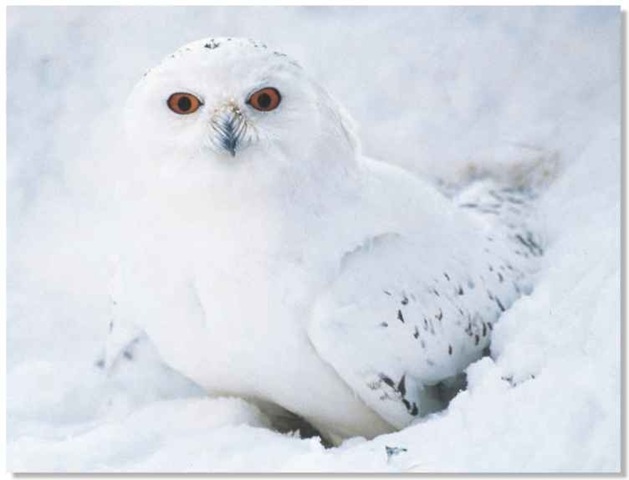ORDER
Strigiformes
FAMILY
Strigidae
GENUS & SPECIES
KEY FEATURES
• Most northerly breeding owl; one of very few birds that live permanently in the High Arctic
• Biggest, most powerful flying bird of the far north
• Has adapted its diet to include carrion and is able to go without food for up to 40 days, but is forced to move south when prey is scarce
WHERE in THE WORLD!
Found in a ring around the North Pole in the High Arctic; breeds in the tundra in the far north of Alaska, Canada, Greenland, Europe and Asia, but may migrate farther south

Lifecycle
The snowy owl’s lifestyle in its harsh habitat is dominated by the search for food. Watching from a favorite perch, it may wait for hours — but is always alert and ready to strike.
Habitat
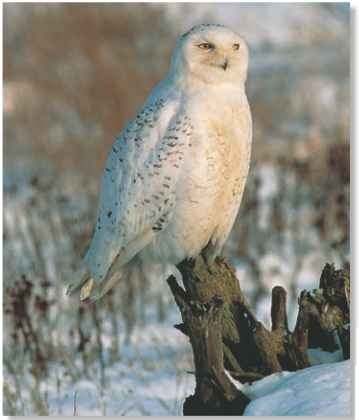
A Statue in the snow Camouflaged against white, the owl chooses a tall perch in open ground.
The owl’s range includes polar ice and frozen tundra north of the treeline, but it is nomadic and in the depths of winter may migrate south to Canadian prairies and the northern United States. Snowy owls have been sighted as far south as Virginia and northern Texas. When crossing open sea, owls may rest on icebergs or ice floes, and bad weather has even forced them to land on ships.
Wherever it settles, the owl favors areas of low, open ground where dry, rocky hillocks stand exposed from the snow. Perched on such ridges and mounds, it has a good view. Farther south in winter, it can often be found perched on a pole or fence post.
Behavior
The snowy owl is among the most silent of all owls. It calls when claiming territory in spring and near the nest in summer but is otherwise quiet. The territorial display call is a loud, deep, hollow hoot, which can carry 2 miles in clear Arctic air. If disturbed at the nest, it makes loud barks and quacks. Females also have loud wails.
Unless it’s near the nest, the snowy owl is shy and difficult to get close to. It will often fly off at the approach of a human or large predator, even if the threat is still almost a mile away.
If an intruder approaches a female on a nest, she may distract it by rolling on the ground as if injured. She’ll usually be aggressive,
stretching her head, opening her wings or tearing grass from the ground and shaking it. Her mate will fly over the intruder,
Well hidden snowy owls remain silent and are hard to spot.
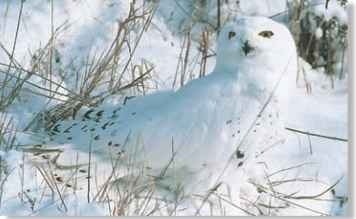
Because of its round face and yellow eyes, the snowy owl is known as the cat owl in some countries.
Even before they hatch, owl chicks start to call to their mother.
The snowy owl is reportedly able to swallow a small rabbit whole.
conservation
Previously hunted and trapped in some parts of its range, the snowy owl is now protected from this threat. The species does face a growing threat in the form of increasing human encroachment on its remote habitat, which is likely to restrict its range and deplete its prey.
Food & hunting
The snowy owl hunts by day, even during dim daylight of the Arctic winter It also feeds on carrion, such as a seal’s carcass or Arctic fox.
Watching from its perch above the field, the snowy owl can spot prey over half a mile away. It flies low over the ground to reach its quarry, striking with talons extended. Most prey is smal and is killed in the first attack, but a large animal is pecked on the head to kill it.

Powerful flier A snowy owl launches its airborne attack.
Tasty morsel Lemmings are one of its staple prey.
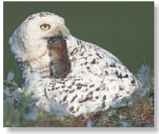
silent swoop
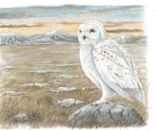
Patient wait…
From its rocky perch, the owl surveys the snowfield. It can sit motionless for hours until it spots a likely meal.
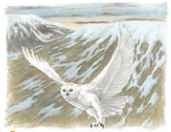
Silent approach…
Leaving its perch, the owl drops low over the terrain in stealthy flight. Its prey is unlikely to spot the white plumage against snowbound slopes.
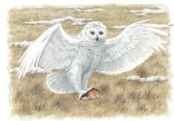
Attack…
With sharp talons thrust forward, the snowy owl swoops on its victim. Small animals, such as lemmings, are killed instantly.
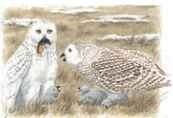
Feed
Small prey is normally swallowed whole, but a breeding snowy owl with chicks to feed will take the kill back to the nest.
Breeding
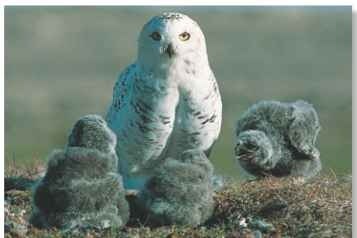
Scruffy chicks Owlets are camouflaged and kept warm by their coats of gray down.
Because of its nomadic life, the owl doesn’t form a pair bond with the same mate for more than one season.The nest is just a simple hollow, scraped out of frozen turf and mosses, usually on a ridge.
The female lays an egg every two to four days. She will lay more eggs in a year when food is plentiful. Each egg hatches a few days after the last, so the first chick is bigger than later ones.The female feeds it first; the other chicks eat only if there is enough food.This helps ensure the strongest chick survives. Hatchlings are covered in dark-gray down, which helps absorb heat and also makes the chicks less conspicuous to predators. After two months, the chicks are fully fledged.
Profile
SNOWY OWL
The snowy owl’s dense plumage insulates it against the cold. In the female, barred feathers help camouflage her as she sits on her eggs.
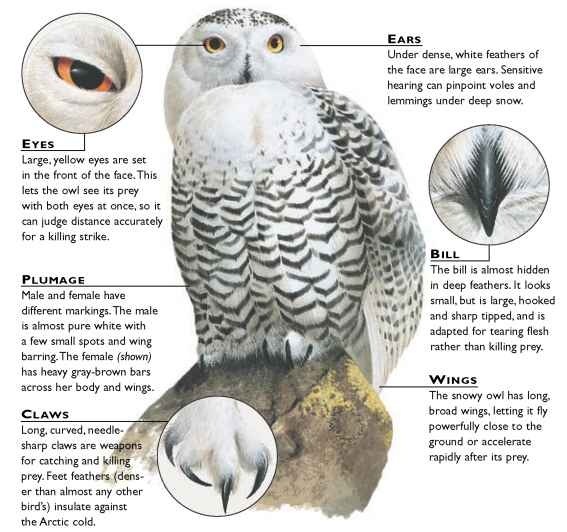
Creature comparisons
Most owls hunt at night or in twilight, but the snowy owl hunts by day — in the Arctic summer, when the sun never fully sets, it has little choice. Like the snowy owl, the Eurasian eagle owl (northern Europe) is powerfully built and preys on small rodents. It lives in more temperate conditions, hunting by night on the edges of woodlands and forests. Because its prey aren’t subject to large fluctuations in numbers, the eagle owl is less migratory than the snowy owl and tends to stay in one region.
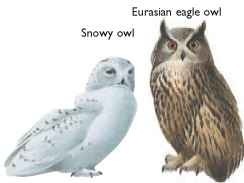
| VITAL STATISTICS Weight 4-6 lbs. Length 21-26″ Wingspan 4.7-5.4′ |
|
| Sexual Maturity | Probably 3-5 years , |
| Breeding Season |
May to early September |
| Number of Eggs | Usually 5-7 but ranges from 2-16 |
| Incubation Period | 30-33 days |
| Fledging Period | 60 days |
| Breeding Interval | 1 year |
| Typical Diet | Lemmings, voles, rabbits, hares; various seabirds |
| Lifespan | 8-10 years |
RELATED SPECIES
• There are about 175 species of true owl, family Strigidae, distributed all over the world, and 10 barn owls in the family Tytonidae. The snowy owl has no close relatives in Strigidae, but is thought to evolve from species similar to big eagle owls, which occupy a similar ecological food niche. The northern treeline marks the northern limit of the Eurasian eagle owl’s range and the southern border of the snowy owl’s range.
